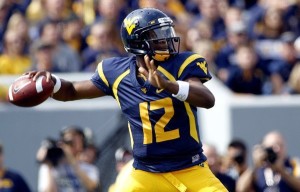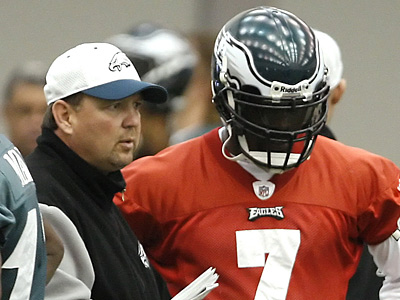by Chase Stuart
on May 24, 2013

Smith throws a pass in between refreshing Twitter.
As
Jason Lisk has pointed out, quarterbacks drafted first overall tend to be much more successful than other quarterbacks, even those drafted just a few picks later. If a quarterback is an elite prospect — think
John Elway or
Peyton Manning or
Andrew Luck (the Colts got three of those for one
Jeff George) — he’ll go first overall, while lesser-skilled quarterbacks might get “overdrafted” because of the position they play. There are counter-examples, of course — think
Matt Ryan and
Joe Flacco in 2008 — but I agree with Jason on the general theory.
One could argue that if you group together all quarterbacks drafted in the first three rounds (after removing the top five or ten picks), you won’t find any significant relationship between draft slot and performance. That’s not where this post is going, though. Instead I’ll take a narrower view and note that Geno Smith became the 44th quarterback drafted in the second half of the first round or the first half of the second round since 1978. Those cut-offs should give us a good look at quarterbacks ignored by teams picking in the top half of the first round but quarterbacks who were otherwise good enough to be drafted relatively early. This analysis generally applies to EJ Manuel, too, although he technically misses the cut-off as the 16th pick of the first round. Once we leave out the quarterbacks drafted since 2009 — Brandon Weeden, Andy Dalton, Colin Kaepernick, Tim Tebow, Jimmy Clausen, Josh Freeman, and Pat White — we’re left with 36 quarterbacks.
The table below shows each of those quarterbacks, along with the year they were drafted, the round, the overall pick, and the team that selected them. How did they turn out? I’ve included their number of seasons starting, number of games and games started, career passing yards and passing touchdowns, and also their number of Super Bowl wins, Super Bowl appearances, and Pro Bowls. The final row shows the median for each category (and for the last three columns, the average). Obviously this will shortchange some of the active quarterbacks, but you get the general idea.
[continue reading…]
Tagged as:
EJ Manuel,
Geno Smith,
Marty Mornhinweg
{ }
by Chase Stuart
on January 20, 2013

Mornhinweg and Vick plan for their dream season.
On Friday, the Jets finally concluded their search for a new offensive coordinator by hiring
Marty Mornhinweg. The reaction was predictably mixed, but one of the facts trumpeted by the pro-Mornhinweg crowd was that he has been an offensive coordinator for 11 years and his teams never ranked lower than 15th on offense. Besides my initial reaction of “well,
that’s about to change“, my next thought was: wait, the 2012 Eagles were a top-fifteen offense?!
Philadelphia turned the ball over 37 times last year, tied with the Jets and the Chiefs for most in the league. The Eagles ranked 29th in points scored. But when people speak of things like a top-fifteen offense, the convention is to refer to a team’s rank in yards gained, and Philadelphia did rank 15th in yards in 2012.
[continue reading…]
Tagged as:
Andy Reid,
Eagles,
Jets,
Marty Mornhinweg
{ }


